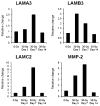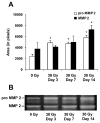Laminin 332 deposition is diminished in irradiated skin in an animal model of combined radiation and wound skin injury
- PMID: 21854211
- PMCID: PMC3227557
- DOI: 10.1667/rr2422.1
Laminin 332 deposition is diminished in irradiated skin in an animal model of combined radiation and wound skin injury
Abstract
Skin exposure to ionizing radiation affects the normal wound healing process and greatly impacts the prognosis of affected individuals. We investigated the effect of ionizing radiation on wound healing in a rat model of combined radiation and wound skin injury. Using a soft X-ray beam, a single dose of ionizing radiation (10-40 Gy) was delivered to the skin without significant exposure to internal organs. At 1 h postirradiation, two skin wounds were made on the back of each rat. Control and experimental animals were euthanized at 3, 7, 14, 21 and 30 days postirradiation. The wound areas were measured, and tissue samples were evaluated for laminin 332 and matrix metalloproteinase (MMP) 2 expression. Our results clearly demonstrate that radiation exposure significantly delayed wound healing in a dose-related manner. Evaluation of irradiated and wounded skin showed decreased deposition of laminin 332 protein in the epidermal basement membrane together with an elevated expression of all three laminin 332 genes within 3 days postirradiation. The elevated laminin 332 gene expression was paralleled by an elevated gene and protein expression of MMP2, suggesting that the reduced amount of laminin 332 in irradiated skin is due to an imbalance between laminin 332 secretion and its accelerated processing by elevated tissue metalloproteinases. Western blot analysis of cultured rat keratinocytes showed decreased laminin 332 deposition by irradiated cells, and incubation of irradiated keratinocytes with MMP inhibitor significantly increased the amount of deposited laminin 332. Furthermore, irradiated keratinocytes exhibited a longer time to close an artificial wound, and this delay was partially corrected by seeding keratinocytes on laminin 332-coated plates. These data strongly suggest that laminin 332 deposition is inhibited by ionizing radiation and, in combination with slower keratinocyte migration, can contribute to the delayed wound healing of irradiated skin.
Figures










References
-
- Messerschmidt O. Whole-body irradiation plus skin wound: animal experiments on combined injuries. Br J Radiol Suppl. 1986;19:64–7. - PubMed
-
- Augustine AD, Gondre-Lewis T, McBride W, Miller L, Pellmar TC, Rockwell S. Animal models for radiation injury, protection and therapy. Radiat Res. 2005;164:100–9. - PubMed
-
- Ran X, Cheng T, Shi C, Xu H, Qu J, Yan G, et al. The effects of total-body irradiation on the survival and skin wound healing of rats with combined radiation-wound injury. J Trauma. 2004;57:1087–93. - PubMed
Publication types
MeSH terms
Substances
Grants and funding
LinkOut - more resources
Full Text Sources
Other Literature Sources
Miscellaneous

